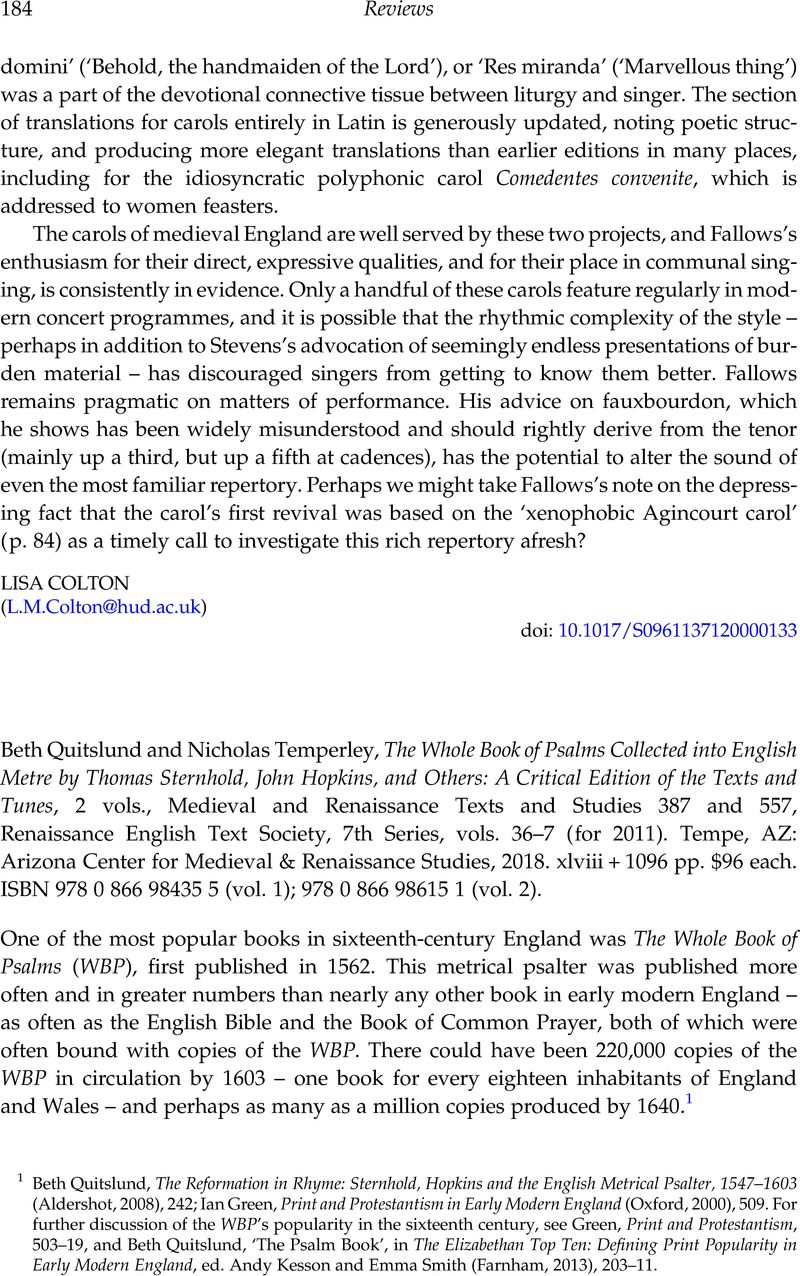No CrossRef data available.
Article contents
Beth Quitslund and Nicholas Temperley, The Whole Book of Psalms Collected into English Metre by Thomas Sternhold, John Hopkins, and Others: A Critical Edition of the Texts and Tunes, 2 vols., Medieval and Renaissance Texts and Studies 387 and 557, Renaissance English Text Society, 7th Series, vols. 36–7 (for 2011). Tempe, AZ: Arizona Center for Medieval & Renaissance Studies, 2018. xlviii + 1096 pp. $96 each. ISBN 978 0 866 98435 5 (vol. 1); 978 0 866 98615 1 (vol. 2).
Published online by Cambridge University Press: 15 September 2020
Abstract

- Type
- Reviews
- Information
- Copyright
- Copyright © Cambridge University Press, 2020
References
1 Quitslund, Beth, The Reformation in Rhyme: Sternhold, Hopkins and the English Metrical Psalter, 1547–1603 (Aldershot, 2008), 242Google Scholar; Green, Ian, Print and Protestantism in Early Modern England (Oxford, 2000), 509CrossRefGoogle Scholar. For further discussion of the WBP's popularity in the sixteenth century, see Green, Print and Protestantism, 503–19, and Quitslund, Beth, ‘The Psalm Book’, in The Elizabethan Top Ten: Defining Print Popularity in Early Modern England, ed. Kesson, Andy and Smith, Emma (Farnham, 2013), 203–11Google Scholar.
2 The older, traditionalist model of Dickens, A. G.: The English Reformation (New York, 1964, repr. 1974)Google Scholar.
3 The revisionist model, in chronological order: Bossy, John, The English Catholic Community 1570–1850 (Oxford, 1976)Google Scholar; Scarisbrick, J. J., The Reformation and the English People (Oxford, 1984)Google Scholar; Haigh, Christopher, ed., The English Reformation Revised (Cambridge, 1987)CrossRefGoogle Scholar; Collinson, Patrick, The Birthpangs of Protestant England: Religious and Cultural Change in the Sixteenth and Seventeenth Centuries (New York, 1988)Google Scholar; Duffy, Eamon, The Stripping of the Altars: Traditional Religion in England c.1400–c.1580 (New Haven, 1992; 2nd edn 2005)Google Scholar; Haigh, Christopher, English Reformations: Religion, Politics, and Society under the Tudors (Oxford, 1993)Google Scholar.
4 Early and well-known examples of post-revisionist studies include Jones, Norman, The English Reformation: Religious and Cultural Adaptation (Oxford, 2002)Google Scholar; Marshall, Peter, Beliefs and the Dead in Reformation England (Oxford, 2002)CrossRefGoogle Scholar; Marsh, Christopher, Popular Religion in Sixteenth-Century England: Holding their Peace (New York, 1998)CrossRefGoogle Scholar; Walsham, Alexandra, Providence in Early Modern England (Oxford, 1999)Google Scholar.
5 Fox, Adam, Oral and Literate Culture in England, 1500–1700 (Oxford, 2000)Google Scholar; Green, Ian, The Christian's ABC: Catechisms and Catechizing in England c.1530–1740 (Oxford, 1996)CrossRefGoogle Scholar; idem, Humanism and Protestantism in Early Modern English Education (Farnham, 2009); Salter, Elisabeth, Popular Reading in English c.1400–1600 (Manchester, 2012)Google Scholar; Shell, Alison, Oral Culture and Catholicism in Early Modern England (Cambridge, 2007)CrossRefGoogle Scholar; Wabuda, Susan, Preaching during the English Reformation (Cambridge, 2002)Google Scholar; Watt, Tessa, Cheap Print and Popular Piety, 1550–1640 (Cambridge, 1991)Google Scholar.
6 Duguid, Timothy, Metrical Psalmody in Print and Practice: English ‘Singing Psalms’ and Scottish ‘Psalm Buiks’, c.1547–1640 (Farnham, 2014)Google Scholar; Green, Print and Protestantism; Hamlin, Hannibal, Psalm Culture and Early Modern English Literature (Cambridge, 2004)Google Scholar; Marsh, Christopher, Music and Society in Early Modern England (Cambridge, 2010)Google Scholar; Quitslund, The Reformation in Rhyme; Willis, Jonathan, Church Music and Protestantism in Post-Reformation England: Discourses, Sites and Identities (Farnham, 2010)Google Scholar; Zim, Rivkah, English Metrical Psalms: Poetry as Praise and Prayer, 1535–1601 (Cambridge, 1987)Google Scholar.
7 Temperley, Nicholas, The Music of the English Parish Church, 2 vols. (Cambridge, 1979)Google Scholar; idem, The Hymn Tune Index: A Census of English-Language Hymn Tunes in Printed Sources from 1535 to 1820, 4 vols. (Oxford, 1998); idem, ‘“All skillful praises sing”: How Congregations Sang the Psalms in Early Modern England’, Renaissance Studies, 29 (2015), 531–53.
8 Beth Quitslund, ‘Authors, Copy Texts, and Other Casualties of Editing The Whole Book of Psalms’, paper given at the Sixteenth-Century Society conference, St Louis, Missouri, 18 October 2019.
9 Quitslund, ‘Authors, Copy Texts, and Other Casualties’.


